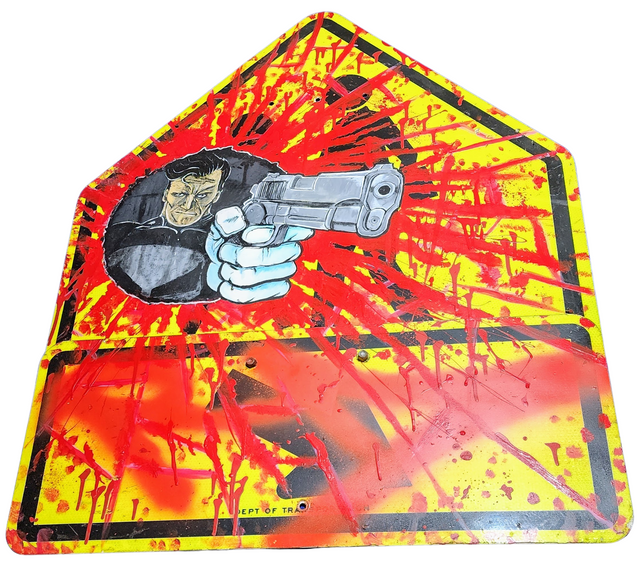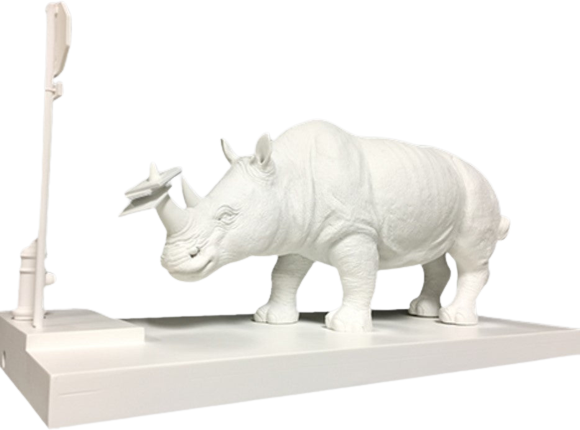
Street Signs
-

Josh Keyes The Collector Sculpture by Josh Keyes
The Collector Limited Resin Sculpture Artwork by Modern Pop Artist Josh Keyes. 2017 Limited Edition Displayed With Box The Collector - is the 3rd sculpture by Josh Keyes from our Signature Series. Once started as a beautiful painting, it has now been turned into a fully detailed sculpture with a classy Matte White finish. Sculpture Size: 18" L x 7" W x 9" H approximately Medium: Resin Josh Keyes' "The Collector" stands as a remarkable manifestation of modern pop art, embodying the fusion of street art sensibilities and acceptable art discipline. This 2017 limited edition resin sculpture is the third in Keyes' acclaimed Signature Series, which captures his work's striking visual narratives and meticulous detail. The Transition from Canvas to Sculpture Originally conceived as a painting, "The Collector" transformed into a fully realized three-dimensional form, retaining its two-dimensional predecessor's intricate detail and profound thematic elements. The transition from painting to sculpture allowed for a new interpretation of Keyes' vision, presenting it in a tangible, touchable medium. The sculpture's matte white finish enhances its sophisticated silhouette, emphasizing the clean lines and the stark contrast between the subject and its environment. The sculpture commands presence with dimensions of approximately 18 inches in length, 7 inches in width, and 9 inches in height. Cast in resin, a medium celebrated for its durability and acceptable detail capacity, "The Collector" is both a robust and delicate piece, a testament to Keyes' ability to navigate the complexities of form and substance. A Statement in Street Pop Art & Graffiti Artwork "The Collector" resonates within street pop art and graffiti artwork through its bold statement and presence. Despite its pristine finish, the piece carries the spirit of street art—challenging the observer, engaging with environmental themes, and commenting on the interaction between the natural world and human-made structures. The rhinoceros, a frequent subject in Keyes' work, is depicted alongside a street light, a juxtaposition that invites viewers to contemplate the intrusion of urban development into natural habitats. In the broader context of Josh Keyes' portfolio, "The Collector" is a signature work that showcases his concern with ecological and post-apocalyptic themes. Keyes' art often features wild animals in urban settings, exploring the boundaries between human civilization and the natural world, a theme that resonates deeply in today's ecologically conscious society. The Cultural Impact of "The Collector" As a piece of art, "The Collector" transcends mere aesthetics to engage in a cultural dialogue. It visually explores the clashes and coexistence between urban life and nature. The sculpture's stark white color serves as a canvas, highlighting the shadows and contours of the piece and allowing the form to become the central narrative. This absence of color suggests a tabula rasa, or a blank slate, inviting many interpretations from the audience. Josh Keyes' work, particularly "The Collector," aligns with the ethos of modern pop art by drawing on recognizable imagery and repurposing it within a new context. In doing so, he creates a discourse that is accessible yet laden with depth, much like the street art and graffiti that adorn the walls of cities worldwide. It is a discourse that speaks to the ubiquity of environmental change and the pervasive impact of human influence on the natural world. In conclusion, Josh Keyes' "The Collector" is a profound piece that captures the essence of contemporary issues through the lens of street pop art and graffiti artwork. Its transformation from a detailed painting to a sculptural form allows it to occupy physical space and engage with audiences directly and tactilely. Through this work, Keyes continues to challenge viewers, prompting them to reflect on the intersection of human and animal domains and the delicate balance that must be maintained between progress and preservation. The sculpture, with its limited availability, not only serves as a piece of art but also as a collectible item that mirrors our society's current ecological and cultural challenges.
$365.00


